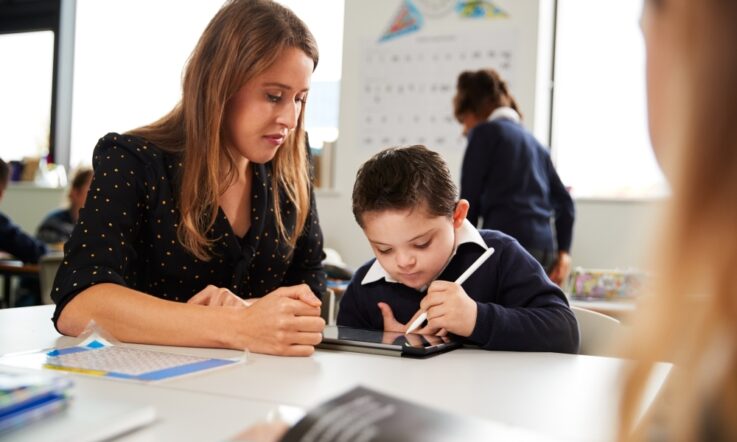In part one of this two-part series, we presented some benefits of inclusive education, as well as some common challenges that teachers face when planning for and enacting inclusive education.
In this article, we share some practical and research-informed strategies, to combine with your existing expertise and favoured teaching approaches that will support you in teaching inclusively. Specifically, we will describe a way to integrate High Impact Teaching Strategies (or HITS) into a Universal Design for Learning (or UDL) framework.
Universal Design for Learning and High Impact Teaching Strategies
Universal Design for Learning (UDL) is an approach to teaching and learning that aims to give all students equal opportunities to learn. UDL is based on the assumption that there is no ‘regular’ or ‘average’ student; rather, it recognises that all students are different and unique with respect to their learning history, strengths, preferences, and areas of need.
In this approach student difference is the norm, rather than the exception, in the classroom setting. For this reason, UDL is beneficial in all educational settings because it is designed to improve the learning experience and outcomes for all students.
Rather than a teaching strategy, UDL is a blueprint for delivering a range of different teaching strategies. The blueprint can guide the process of developing and delivering inclusive education in the following ways, many of which you are probably already doing:
- Determine what it is you want students to know and do at the end of the lesson.
- Decide how you will assess student learning, using both formative and summative assessment methods. In addition, decide if one, some, or all students will need accommodations or modifications to participate in assessment.
- Identify any barriers to learning that your students may experience (or ask students what barriers they feel they are experiencing).
- Create your lesson plan with student strengths and these barriers in mind, and take steps to reduce barriers to learning by proactively providing accommodations or modifications for one, some, or all students.
- Teach your lesson using a range of teaching strategies that provide all students with lots of opportunities to respond, demonstrate their learning, and receive feedback.
- Reflect on your teaching – what worked, and what would you do differently next time?
In addition to the steps in the blueprint, UDL is underpinned by three principles:
- Provide multiple means of representation. This involves presenting content in different formats, such as text, pictures, audio, video, modelling, etc.
- Provide multiple means of engagement. This involves providing students with different ways to actively engage with the content.
- Provide multiple means of action and expression. This involves providing students with different ways to demonstrate their learning.
Once these three principles are planned for, we can begin to weave in High Impact Teaching Strategies.
As you may be aware, High Impact Teaching Strategies (HITS) are evidence-based teaching practices that have been identified as most likely to improve student learning. HITS may include strategies for designing instruction, strategies for enacting instruction, and strategies for assessing student learning. HITS are not designed to replace the type of teaching strategies teachers are currently using with success, but should be used strategically to complement other existing effective practices.
Why might integrating HITS into the UDL framework help teachers?
We propose that UDL and HITS are complementary, rather than substitutable, ways to deliver high quality education to all students. Both UDL and HITS are flexible. That is, they are meant to provide guidance rather than rules around how to deliver inclusive education.
In addition, both UDL and HITS are underpinned by a strengths-based approach and adopt a success mindset. That is, UDL and HITS are underpinned by the idea that all students can and will learn and succeed when provided with the right support. If students are not succeeding in the classroom, the solution is to evaluate how the learning context can be adapted to better meet their needs, rather than viewing the problem as originating from within the students themselves.
We consider UDL to be the blueprint for delivering high quality education that is matched to student needs, and HITS to be the specific strategies used within the blueprint. By integrating UDL and HITS, teachers may be better prepared to deliver more inclusive education. Here are five tips for integrating UDL and HITS to deliver effective and inclusive education that will proactively meet the needs of diverse learners.
Tip #1: Make learning outcomes clear and purposeful (UDL) by setting goals (HITS)
To positively impact learning, the purpose of each lesson must be clear, succinct, specific and measurable. Whilst we as teachers may be clear on the learning goals (or intentions) for each lesson, the learner must be also. We recommend avoiding verbs such as ‘will know’ or ‘will understand’ when developing goals, as these terms are subjective and can be difficult to measure. We recommend incorporating more specific and measurable action verbs, such as identify, describe, create, build, solve, reflect, and analyse. Using clear and measurable action verbs will help students identify and describe what they are expected to be able to say and do by the end of the lesson (success criteria).
Writing goals in this way can also support students in carrying out self and peer assessment. Starting with clear, specific, and measurable goals will then help you strategically design assessment tasks and select and deliver content that helps students achieve the stated goals (illustrating the process of constructive alignment).
Tip #2: Ensure students are provided with instruction that is well-aligned to learning outcomes (UDL) by structuring lessons (HITS) and using differentiated teaching (HITS)
Once you have specific and measurable learning goals, you can use the concept of backward design to structure lessons, ensuring that all students are given the necessary support to achieve what is expected of them. Structuring lessons involves creating learning materials and learning activities that are well-aligned to the learning goal.
When structuring lessons, the first step is to identify the students’ current performance level. This will allow you to build on what students can already do and say, while not setting learning expectations that are not realistic or achievable. Structuring lessons should help you meet students where they are at. At this stage, you might also consider how you will differentiate your teaching and activities for some students who need additional support. Differentiation might include providing accommodations, such as more time to complete a task, a calculator, computer, word bank, or graphic organisation, or more detailed step-by-step instructions.
Tip #3: Ensure students are provided with multiple means of representation (UDL) by incorporating worked examples (HITS) and multiple exposures (HITS)
Providing students with worked examples and multiple exposures can help provide multiple means of representation. Worked examples provide students with a sequence of steps to follow to complete a task or solve a problem. However, as we know, tasks can be performed in different ways. Creating worked examples that show different ways of completing a task or solving a problem can help facilitate flexible and creative ways of thinking and doing.
Worked examples can also be provided in different formats, such as demonstrations, text, video, and pictures. Different worked examples can be provided using multiple exposures. With multiple exposures, concepts are revisited at different times and in different ways. You might consider gradually increasing the difficulty level of a task by providing more complex problems, accompanied by new worked examples, over time. This strategy can help students build fluency with a new concept, and deepen their understanding of the material over time.
Tip #4: Ensure students are provided with multiple means of engagement (UDL) by using explicit teaching (HITS) with questioning (HITS)
First, plan how you will break the larger skill you are teaching down into small teachable components, and use explicit teaching to deliver the foundational knowledge (or building blocks) that all students need. Explicit teaching involves a combination of modelling, practise, and feedback.
Modelling provides you with an opportunity to show students how to perform the skill, practice provides students with the opportunity to perform the skill themselves (e.g., allows for active student engagement), and feedback allows you to provide both corrections and positive statements to students to help shape their learning. Here, we recommend emphasising the practise element of explicit teaching, using questioning.
Questioning can be used to create lots of opportunities for students to respond, stimulate student curiosity, and enhance student motivation. Closed-ended questions can be used to help with recall and facts, and open-ended questions can be used to help students explain, relate, and synthesise what they are learning. It may involve the teacher asking questions of the students (and recruiting individual or choral student responses), or the students asking questions of the teacher. Questioning provides you with in-the-moment opportunities to gauge student understanding of the material and adjust your teaching as needed (either increase or decrease the difficulty level, or your level of assistance).
Tip #5: Ensure students are provided with multiple means of action and expression (UDL) using collaborative learning (HITS)
Collaborative learning allows students the opportunity to work together in groups to solve problems and complete tasks. Following explicit instruction in the foundational concepts, collaborative learning can provide students with an opportunity to explore the content in new ways (and is a great time to incorporate more inquiry-based strategies!).
It’s important for groups to be structured and goal oriented, to ensure students can remain on-task and engaged. Students within the group may take on different roles as part of the task, to practise different skills (such as speaking, note taking, instruction following, giving feedback, etc.). Collaborative learning also provides students with opportunities to ‘be the teacher’ and teach concepts to others, which may deepen their own understanding of the material.
Supporting behaviour and wellbeing
In addition to supporting the academic success of students, the integration of UDL and HITS may also support student behaviour and wellbeing. Students who display challenging behaviour are less likely to participate in learning activities (and thus likely to fall further behind their peers), and are more likely to experience exclusionary disciplinary practices (which further remove them from meaningful learning opportunities). Decades of research suggests that the best way to proactively prevent (and effectively address) challenging behaviour is through the teaching of new skills (Ashdown & Bernard, 2012; Sugai & Horner, 2008).
To be optimally effective, teaching must be matched to the needs of the student, and meet the student where they are at. UDL and HITS provide guidance to teachers about how to adapt their teaching to meet the needs of diverse learners, using a continuum of flexible strategies. What is presented here is only one part of the puzzle, and you will decide if, when and how this approach will be best used in your school and/or classroom space.
References
Ashdown, D. M., & Bernard, M. E. (2012). Can explicit instruction in social and emotional learning skills benefit the social-emotional development, well-being, and academic achievement of young children?. Early Childhood Education Journal, 39(6), 397-405.
Sugai, G., & Horner, R. H. (2008). What we know and need to know about preventing problem behavior in schools. Exceptionality, 16(2), 67-77.
Further reading and resources
ADCET (Australian Disability Clearinghouse on Education and Training). (2021). Webinar: Designing Online Education that Works for All Students – A 7-Step UDL Approach. https://www.adcet.edu.au/resource/10679/adcet-webinar-designing-online-education-that-works-for-all-students-a-7-step-udl-approach
Archer, A. L., & Hughes, C. A. (2010). Explicit instruction: Effective and efficient teaching. Guilford Publications.
Hall, T. E., Meyer, A., & Rose, D. H. (Eds.). (2012). Universal design for learning in the classroom: Practical applications. Guilford Press.
Ministry of Education New Zealand.(n. d.). Guide to Universal Design for Learning. TKI Te Kete Ipurangi, Inclusive Education. https://www.inclusive.tki.org....
Victoria State Government. (2020). High Impact Teaching Strategies. Excellence in Teaching and Learning. Department of Education and Training. https://www.education.vic.gov.au/Documents/school/teachers/support/high-impact-teaching-strategies.pdf (PDF, 859KB)
Wakefield, M. A. (2018). UDL and the learning brain. CAST. https://www.cast.org/binaries/content/assets/common/publications/articles/cast-udlandthebrain-20190501.pdf (PDF, 593KB)
Reflect on the three principles described above which underpin Universal Design for Learning.
With a colleague, discuss a recent unit of work you both taught. Did you effectively plan for these three principles?
How could you work towards planning for these three principles with the aim of then integrating High Impact Teaching Strategies in an upcoming unit of work?



